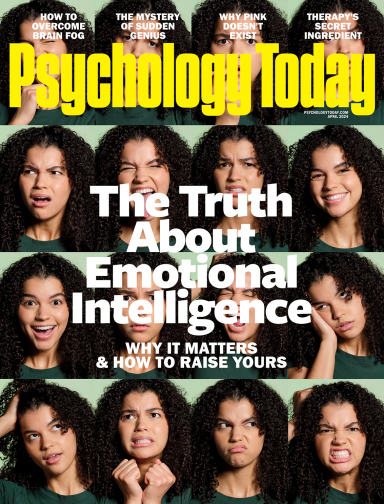Mating
Who Is Attractive and Compatible as a Romantic Partner?
To find the right partner, pay attention to both what you feel and think.
Posted December 31, 2013 Reviewed by Ekua Hagan
Key points
- Successful long-term relationships are driven by both passion and compatibility.
- Feelings of passion for a romantic partner tend to be based on unconscious desires, while compatibility is usually based on conscious ones.
- People initially tend to choose lovers based on their unconscious, emotional reactions.
Welcome back to The Attraction Doctor
Most everyone has their "wish list" of traits that they hope to find in their ideal boyfriend, girlfriend, partner, spouse, or lover. In fact, when such a list of needs and wants is reasonable, it helps in finding a satisfying relationship (see here and here). Nevertheless, having such a list does not completely guarantee that a person will use it to select a compatible partner.
It appears that these logical ideals often get forgotten when someone comes face-to-face with a real-life potential lover. Perhaps you yourself have had this happen. Have you thought about some features you want to find in Mr. or Ms. Right, only to get attracted and choose someone who had none of those features? If so, you are certainly not alone.
Unfortunately, if that attraction leads someone away from their desired list of compatible traits, there are often long-term consequences. Certainly, passionate flings are fun. If you want to build a longer-term relationship, however, then that list of must-have compatibility traits becomes very important too.
As a result, many single people face a dilemma. Some get swept away by passion, only to have relationships not work out due to a lack of compatibility. Others choose to stay mindful of their list of must-have traits, yet never seem to feel that "spark" of attraction with anyone who has those traits.
So, what is going on? As usual, research can help us out...
How Compatibility Ideals Work Out in Real Life
Fortunately for us, Eastwick, Luchies, Finkel, and Hunt (2013) addressed this very issue of "The Predictive Validity of Ideal Partner Preferences" in a massive review and meta-analysis of research. In other words, they evaluated how these ideal trait preferences predict actual success and satisfaction in relationships. The authors made several interesting conclusions within their long review. For our purposes, I will highlight the relevant ones to our current question below:
- Individuals do have ideal partner preferences. Multiple studies show that people do have an abstract idea of the features they would like to find in a future lover, partner, or spouse. These ideals differ from person to person, as well as between men and women too. Nevertheless, these ideals often fall within predictable patterns of importance in three different categories; a) warmth/trustworthiness, b) attractiveness/vitality, and c) status/resources. Thus, although individuals may differ on the priority of each of these features in a future partner, the essence of these ideal abstractions is an attempt to find a mate who will cooperate, reproduce well and aid in survival.
- Ideal preferences don't predict initial attraction. Eastwick and associates (2013) noted that the research outcomes changed when they looked at studies involving "actual" date choices as opposed to ideal preferences. There appeared to be far less variation in "actual selections" than in "ideal preferences" among individuals. Furthermore, those ideal preferences that people said they desired, did not actually predict who they chose as a date or mate. Additional research showed that the initial selection of actual dates and mates was actually driven by unconscious, implicit, emotional judgments, rather than conscious, logical, ideal choices. Put simply, people chose initial lovers based on their unconscious, emotional reactions to them—not their conscious list of ideal criteria.
- Ideal preferences do predict later relationship compatibility. The picture again changed when the authors reviewed studies evaluating actual long-term relationships. Within that context, an individual's ideal preferences for the pattern of traits in a partner were quite predictive and informative. Essentially, when partners were compatible, fitting each other's ideal pattern of traits, they were more likely to stay together. Their relationships were more satisfying too. Thus, when both partners "fit" the explicit ideals of the other, long-term relationships tend to work out more often.
- Both conscious ideals and unconscious emotions are important. Finally, Eastwick and associates (2013) wrapped up their findings with a concise model of relationship choices over time. Before individuals meet a potential mate, they form thoughtful ideas in their minds about the traits they want in that future partner (labeled "Abstract Construal"). When they make initial contact with a potential partner, however, they primarily rely on unconscious, implicit emotions to choose (labeled "Romantic Affect"). Then later, after relationships are established, individuals begin to evaluate their romantic partners against their conscious, ideal preferences once again. Therefore, to predict who an individual will ultimately end up with as a long-term mate requires knowing a) what features they are unconsciously attracted to, and b) what features they consciously decide are compatible. Put simply, to predict an individual's relationship choices, it is important to know what unconsciously "turns them on" and what consciously "they want" for the long-term too.
How to Find an Attractive and Compatible Partner
The above research offers some important clues for identifying and choosing a satisfying relationship partner. In fact, they lend themselves nicely to the following steps:
- Know your ideals. Take some time to decide what traits you want in a future boyfriend, girlfriend, lover, or spouse. Also, evaluate what traits you will offer them in return as well. It may be helpful to pay attention to the "big" categories of warmth/trustworthiness, attractiveness/vitality, and status/resources. Just ranking them in terms of importance can help. For example, is it more important that your future partner be attractive, high status, or trustworthy? Similarly, how do you rank on those criteria too? (Note: If you want all of those things, to the max, then you might want to work on being the "whole package" yourself too!)
- Explore your feelings. Pay attention to your emotions and note who you find attractive. Are there any common features? Do you have a "type" that you seem to select over and over again? Stay mindful of these feelings and emotional reactions. As best you can, identify the feelings that tell you who you find unconsciously attractive. Also, if you can identify traits and features that seem to repeatedly "trigger" strong feelings in you, keep an eye out for them too. (Note: You will likely find that the features that trigger your unconscious emotional attraction to a person are very different from the features that you consciously want in an ideal partner.)
- Initially, go with your "gut feelings" of attraction. Your unconscious feelings will play a large part in who you initially "choose" for a date or mate. They are also largely out of your control. Thus, while you cannot change how you feel, you can use it to your advantage. Essentially, once you are mindful of what you find attractive, use those feelings to "narrow down" the list of potential partners. If your "gut" says yes (or even maybe), then keep them as an option.
- Remember to check for conscious compatibility too. Finally, don't let your emotions run away with the whole decision. Feeling attraction is only the first step...not the whole process. So, remember to screen and evaluate those attractive, potential partners for longer-term compatibility too. Do they have the traits that you want? Do you have what they are looking for in return too? When you identify someone who matches your pattern of preferences (and you match their preferences too), then you have found a good long-term relationship partner. Enjoy!
Conclusion
It can be confusing to pick the right partner for a satisfying relationship. At times, conscious criteria and unconscious emotions seem to disagree. As we have found, however, both are important. Only by paying attention to what you feel and what you think, can you truly find a satisfying, long-term partner. Therefore, it is essential to find that mutual emotional "spark" of attraction, but not get lost in it—at least until you decide you are both consciously compatible too!
Until next time...happy dating and relating!
Dr. Jeremy Nicholson
© 2013 by Jeremy S. Nicholson, M.A., M.S.W., Ph.D. All rights reserved.
References
Eastwick, P.W., Luchies, L.B., Finkel, E.J., & Hunt, L.L. (2013). The predictive validity of ideal partner preferences: A review and meta-analysis. Psychological Bulletin. Advance online publication. doi: 10.1037/a0032432


